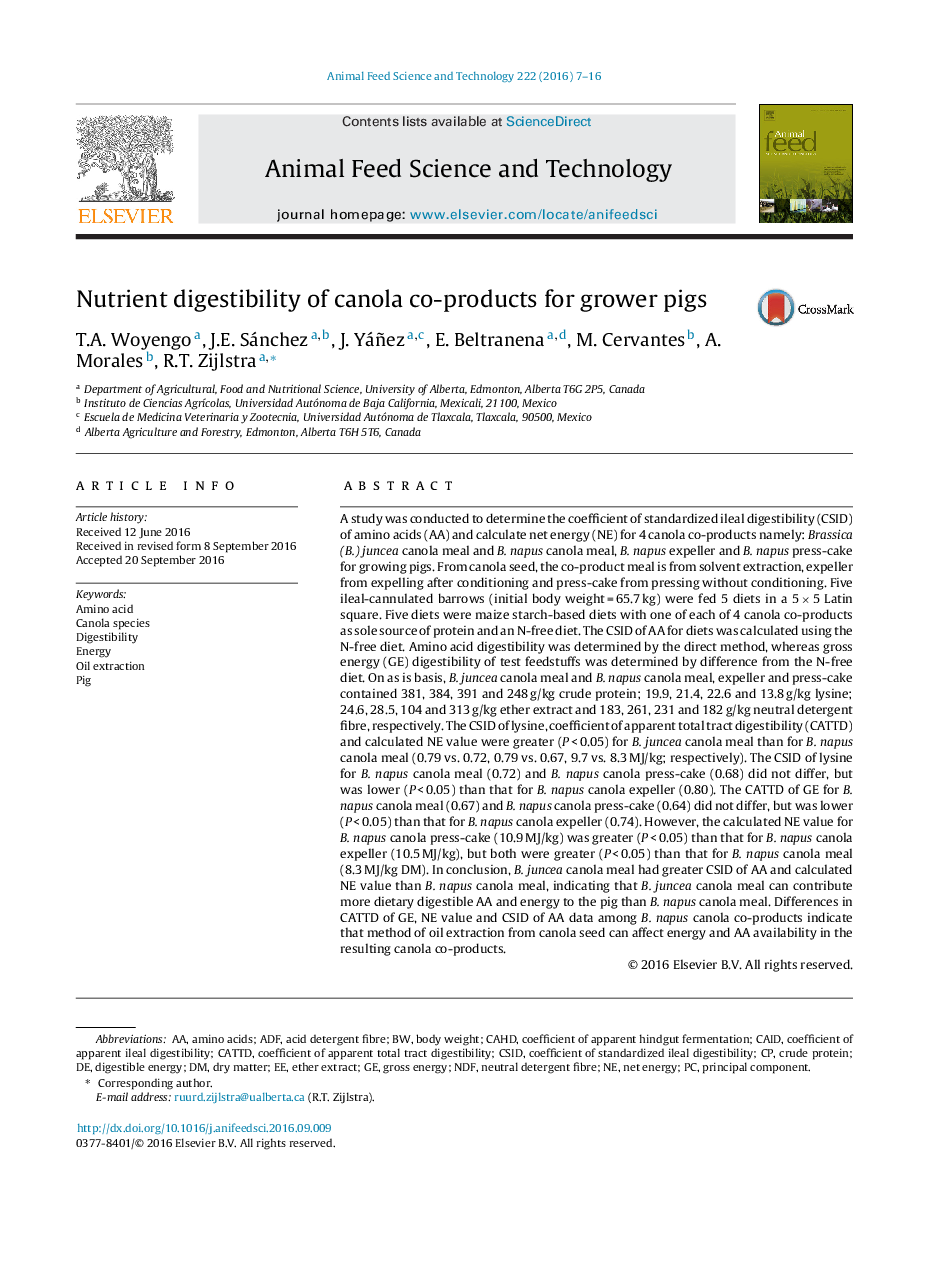| Article ID | Journal | Published Year | Pages | File Type |
|---|---|---|---|---|
| 5538828 | Animal Feed Science and Technology | 2016 | 10 Pages |
Abstract
A study was conducted to determine the coefficient of standardized ileal digestibility (CSID) of amino acids (AA) and calculate net energy (NE) for 4 canola co-products namely: Brassica (B.) juncea canola meal and B. napus canola meal, B. napus expeller and B. napus press-cake for growing pigs. From canola seed, the co-product meal is from solvent extraction, expeller from expelling after conditioning and press-cake from pressing without conditioning. Five ileal-cannulated barrows (initial body weight = 65.7 kg) were fed 5 diets in a 5 Ã 5 Latin square. Five diets were maize starch-based diets with one of each of 4 canola co-products as sole source of protein and an N-free diet. The CSID of AA for diets was calculated using the N-free diet. Amino acid digestibility was determined by the direct method, whereas gross energy (GE) digestibility of test feedstuffs was determined by difference from the N-free diet. On as is basis, B. juncea canola meal and B. napus canola meal, expeller and press-cake contained 381, 384, 391 and 248 g/kg crude protein; 19.9, 21.4, 22.6 and 13.8 g/kg lysine; 24.6, 28.5, 104 and 313 g/kg ether extract and 183, 261, 231 and 182 g/kg neutral detergent fibre, respectively. The CSID of lysine, coefficient of apparent total tract digestibility (CATTD) and calculated NE value were greater (P < 0.05) for B. juncea canola meal than for B. napus canola meal (0.79 vs. 0.72, 0.79 vs. 0.67, 9.7 vs. 8.3 MJ/kg; respectively). The CSID of lysine for B. napus canola meal (0.72) and B. napus canola press-cake (0.68) did not differ, but was lower (P < 0.05) than that for B. napus canola expeller (0.80). The CATTD of GE for B. napus canola meal (0.67) and B. napus canola press-cake (0.64) did not differ, but was lower (P < 0.05) than that for B. napus canola expeller (0.74). However, the calculated NE value for B. napus canola press-cake (10.9 MJ/kg) was greater (P < 0.05) than that for B. napus canola expeller (10.5 MJ/kg), but both were greater (P < 0.05) than that for B. napus canola meal (8.3 MJ/kg DM). In conclusion, B. juncea canola meal had greater CSID of AA and calculated NE value than B. napus canola meal, indicating that B. juncea canola meal can contribute more dietary digestible AA and energy to the pig than B. napus canola meal. Differences in CATTD of GE, NE value and CSID of AA data among B. napus canola co-products indicate that method of oil extraction from canola seed can affect energy and AA availability in the resulting canola co-products.
Keywords
CAIDcoefficient of standardized ileal digestibilityCATTDNDFADFamino acidOil extractionAmino acidsacid detergent fibreEnergynet energyDigestible energygross energyPigcoefficient of apparent ileal digestibilitycoefficient of apparent total tract digestibilityether extractneutral detergent fibreDigestibilitydry matterCSIDprincipal componentbody weightcrude protein
Related Topics
Life Sciences
Agricultural and Biological Sciences
Animal Science and Zoology
Authors
T.A. Woyengo, J.E. Sánchez, J. Yáñez, E. Beltranena, M. Cervantes, A. Morales, R.T. Zijlstra,
